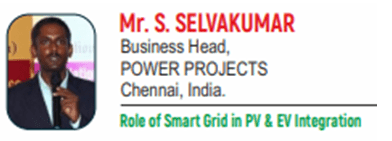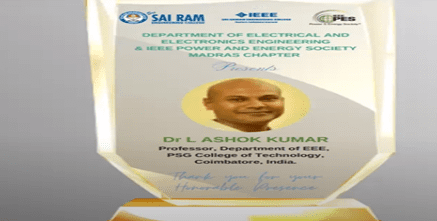Role of Smart Grid in PV & EV Integration
Date & session: 08.05.2023.AN
speaker 1 : Mr. Selvakumar
Keynote:
Load Balancing: Smart Grids facilitate dynamic load balancing. They manage the power demand fluctuations caused by the variable output from PV systems and the irregular charging pattern of EVs, thus ensuring stability. Demand Response: With two-way communication capabilities, Smart Grids can execute demand response strategies. For instance, during peak solar production, EV charging can be incentivized to utilize the excess power effectively. Energy Storage: Smart Grids can coordinate with EVs to act as mobile energy storage units. During periods of low demand or high PV production, EVs can be charged. This stored energy can then be fed back into the grid during peak demand, enhancing grid resilience. Grid Monitoring and Control: Smart Grids offer real-time monitoring and control capabilities. These functions help manage the complexities arising from integrating PV systems and EVs, reducing potential grid failures.

speaker 2 : Dr.N.kumarappan Narayanan
Date & session: 09.05.2023.FN
Keynote:
Interlinking Converter Control: The interlinking converter, which connects the AC and DC subgrids, plays a critical role in maintaining stability. Controlling this converter to ensure power balance while dealing with fluctuating power sources and loads is complex. Protection System: The combination of AC and DC systems increases the complexity of the protection system, making fault detection, isolation, and subsequent system restoration more challenging. Power Quality: Power quality issues, such as harmonics, power factor issues, and voltage sags or swells, can be more difficult to manage in hybrid microgrids. Stability: Maintaining stability in hybrid AC/DC microgrids can be challenging due to the varying dynamics of AC and DC systems.

speaker 3 : Dr. Dr.L.Ashok kumar
Date & session: 09.05.2023.AN
Keynote:
Electric Motor: This is the primary propulsion component, replacing the internal combustion engine in traditional vehicles. EVs can have one or multiple motors. Battery Pack: The battery stores electrical energy used to power the vehicle. Its size and capacity greatly influence the vehicle’s range. Power Electronics: This includes the inverter, which converts DC power from the battery to AC power for the motor, and the onboard charger, which converts AC power from the charging station to DC power to charge the battery. Charging Port: This is where the vehicle connects to a charging station. Energy Management System: This system manages the distribution of electrical power throughout the vehicle and optimizes energy usage.

